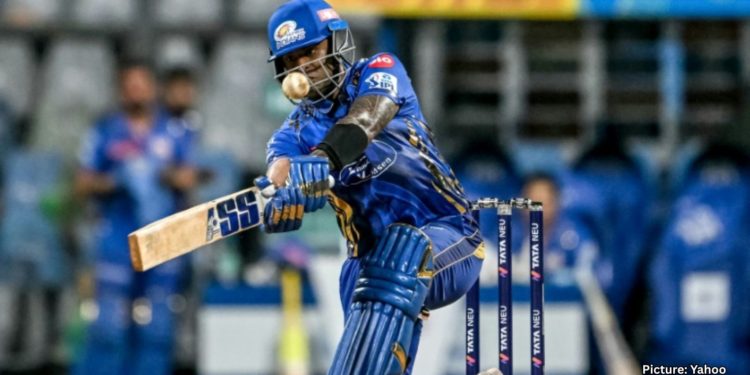Some partnerships in cricket are able to score at more than two runs per ball, while others are lauded by traditional fans. It is a rarity to find one that successfully accomplishes both.
In Friday’s match between GT and SRH, there was a unique partnership of 87 runs between Gill and Sudharsan. It only took 41 balls and consisted of 13 fours and two sixes, all of which were scored during the powerplay. According to ESPNcricinfo’s ball-by-ball data, the shots that contributed to these boundaries were six pulls, three flicks, two cover drives, one straight drive, one steer, one dab, and one cut.
It’s worth noting that the sixth-highest powerplay score of IPL 2025 (82 for no loss) was achieved without any slogs, scoops or reverse hits. This is a true testament to the exceptional batting skills of Gill and Sai Sudharsan, who have consistently displayed their mastery of ball-striking this season. Their partnership on Friday was a perfect display of fluid timing and precise placement.
Upon reviewing the highlights once more, it becomes evident that a majority of the timing and placement was a result of poor bowling by SRH. The initial over from Mohammed Shami, with a half-volley drifting onto Gill’s toes and subsequently flicked for six, set the tone. However, this trend in inaccurate line and length continued throughout every following over.
Shami initially provided Sai Sudharsan with space to hit, but went too far in the following over, resulting in 20 runs. SRH’s captain Pat Cummins then took over and delivered three gentle half-volleys to Gill in the next over, followed by Harshal Patel sending down a half-volley, full-toss, and a high short ball towards Sai Sudharsan in the fifth.
Cummins stated an exceptionally large figure for the expense of SRH’s poor deliveries during the powerplay.
During the broadcast, he admitted that their powerplay performance with the ball was not up to par. He took responsibility for his own mistakes and acknowledged that they gave away 20 or 30 extra runs due to some poor deliveries. Furthermore, there were a couple of catches that they should have held onto in the middle, for which he also takes ownership. Given these factors, chasing a score of 200 seemed more achievable. However, as fate would have it, SRH ultimately had to chase a massive total of 225 runs.
When asked about the difficulty of bowling to Sai Sudharsan and Gill, who currently hold the top two spots in the Orange Cap standings, Cummins shared his perspective.
Gill and Sai Sudharsan possess exceptional batting abilities, but they embody a style reminiscent of the past. They show a faster scoring rate compared to players once dubbed as “anchors” five years ago, yet they remain less inclined than several other opening pairs in the IPL to sacrifice control in pursuit of hitting boundaries at a higher pace.
On Friday, the stars aligned for an ideal combination of batting rhythm, favorable conditions, and lackluster bowling, resulting in a perfect storm for the team. They were able to hit 15 boundaries during the powerplay and maintain a control percentage of almost 92. At one stage, Sai Sudharsan had an impressive strike rate of 244 while also maintaining complete control over his shots.
Out of the 12 powerplays that have resulted in 75-plus scores this season, only GT’s on Friday boasted a control percentage of over 90.
Take a closer look at that graphic. Pay attention to the four blue marks, which represent powerplays where SRH was the bowling side. They have been on the receiving end of one-third of the top 12 highest-scoring powerplays in IPL 2025.
Take a moment to observe the dominant presence of blue at the graphic’s uppermost point. Among the top 12 powerplays of the current season, it is noteworthy that SRH’s bowlers have been involved in the three most successful ones with regard to control percentage.
It’s not by chance that SRH holds the undesirable record for the highest powerplay economy rate (10.65) among all teams this season. This can often be attributed to bowling on a high-scoring home pitch or facing exceptional top-order performances, where even perfectly delivered balls get hit. But it appears that SRH’s powerplay bowling has indeed been an area of concern.
Shami has truly embodied this characteristic. On Friday, he allowed 48 runs in three overs and was unable to bowl a fourth over for the sixth instance in nine games. It has been over five months since his comeback from a year-long injury break, but he still appears to lack the same ferocity on the pitch that renders him a formidable force when fully fit and in rhythm. India will have concerns as they approach five Tests in England.
At the moment, SRH’s focus will be on not only Shami but also the rest of their attack, especially during the first six overs. This season, a lot has been said about SRH’s top order and their decline after a record-breaking 2024. However, their bowling concerns have not received as much attention, despite potentially playing a significant role in their current situation.



















